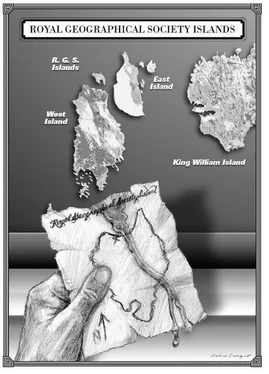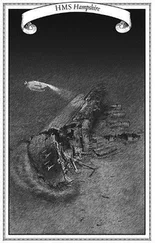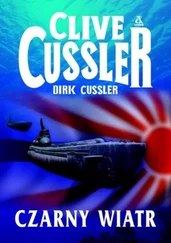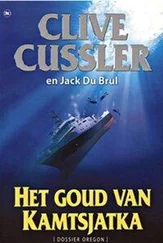Yet for all Bue’s deadweight, Giordino might have been carrying a sack of potatoes. The powerful Italian wasted no time, quickly descending several steps, then kicking off the snow wall and dropping the last several feet into the Zodiac’s rubber hull. Laying Bue down beside the other men, Giordino jumped back out and heaved his body against the bow of the Zodiac. Digging his short, powerful legs into the snow, he shoved the boat off the iceberg, hopping aboard as Dahlgren goosed the outboard motor into reverse.
Dahlgren had barely turned and made headway when a huge swell rolled up in front of them. Giordino reached over and pinned the prone men to the deck as the wave crashed into the bow. Icy foam sprayed everywhere as the Zodiac’s bow shot skyward until the small boat stood nearly vertical. Then the big wave rolled through and away, sending the inflatable crashing into the following trough. Dahlgren steered directly into a second large wave, riding it through with slightly less violence.
As the Zodiac shook off the effects of the second swell, Dahlgren and Giordino glanced back as the two waves pummeled the iceberg. Watching with morbid fascination, they saw the first wave pitch the towering chunk of ice nearly onto its side. Before the berg could right itself, the second wave struck, completely obliterating the iceberg. As the wave rolled past, a few large chunks of ice slowly popped to the surface.
Had they not arrived when they did, Bue, Case, and Quinlon would have been washed into the frigid sea by the twin waves and perished within minutes.
The three Canadians, all suffering from various degrees of hypothermia, were able to cling to life until the wave-tossed Zodiac was clutched from the sea and dropped onto the deck of the Narwhal . Dahlgren had been fortunate enough to locate the research ship in just a few minutes. The storm had obliterated any satellite signals, rendering the GPS unit useless. He instead took a reverse compass heading and motored toward the general position of the ship. The large intervening ice floe had drifted past, allowing an unencumbered route through the high seas. Giordino detected the wail of the ship’s air horn firing a stout blast, and the brightly lit Narwhal appeared through the swirling winds a short time later.
A heavily bundled Rudi Gunn was standing by when the Zodiac hit the deck, and he promptly directed the transfer of the injured men to the medical bay. Bue and Case were revived before long, but Quinlon remained unconscious for several hours as the ship’s doctor worked feverishly to raise the man’s core body temperature. Twice Quinlon’s heart stopped beating and twice he was frantically resuscitated, until his body temperature gradually approached ninety-eight degrees and his blood pressure stabilized.
After shaking the ice off their garments, Giordino and Dahlgren changed into dry clothes and met Gunn on the bridge.
“Do we know if there are any other potential survivors out there?” Gunn asked the two weary men.
Dahlgren shook his head. “I asked the conscious fellow the same question. He told me there were two other men in the ice camp with them but that he is certain they were both killed when the ship tore through the camp.”
“A ship?”
“Not just any ship,” Dahlgren nodded grimly. “An American Navy warship. Came blasting through the ice and obliterated the entire facility.”
“That’s impossible,” Gunn replied.
“I’m just telling you what the man said.”
Gunn fell silent, his eyes bulging in disbelief. “We’ll search some more, all the same,” he finally said in a low voice. Then, turning a sympathetic eye toward both men, he added, “That was a heroic rescue effort under terrible conditions.”
“I wouldn’t have wanted to trade places with those guys,” Giordino remarked. “But Dahlgren a hero? That will be the day,” he added with a laugh.
“I’ve a good mind not to share my bottle of Jack Daniel’s with you for that remark,” Dahlgren retorted.
Giordino put an arm around the Texan and escorted him off the bridge.
“Just one shot, my friend, and I’ll see that the Yukon is yours for the taking.”
THE NARWHAL SEARCHED THE surrounding seas for the next two hours, finding only the battered remnants of a blue awning among the ice-infested waters. Gunn reluctantly called off the search when most of the broken floe fragments finally drifted clear of the ice shelf.
“Prudhoe Bay would have better facilities, but Tuktoyaktuk is the closer port by about fifty miles. They do have an airfield,” Stenseth said, eyeing a chart of the North American coastline.
“We’ll have more of a following sea-sailing to the latter,” Gunn replied, looking over the captain’s shoulder. “It would probably be best to get them ashore as soon as possible. Tuktoyaktuk it is.”
The town was along a sparse stretch of northern Canadian shoreline, just east of the Alaskan border. The area was well north of the Arctic Circle and beyond the northern tree line as well, a rolling, rocky land covered in snow most of the year.
The Narwhal plowed through rough waters for fourteen hours as the spring storm finally blew itself out. The Beaufort Sea still heaved with high breakers when the NUMA ship edged into the protected waters of Kugmallit Bay beside the town of Tuktoyaktuk. A Canadian Mountie patrol boat guided the ship to the city’s industrial pier, where an empty dockside berth awaited. Within minutes, the injured scientists were loaded into a pair of vans and whisked to the local medical center. A thorough checkup deemed the men stable enough for further travel, after which they were loaded onto a plane to Yellowknife.
It wasn’t until the next day, when the trio arrived in Calgary on a government jet, that their ordeal became headline news. A media circus ensued, as every major newspaper and television network jumped on the story. Bue’s eyewitness account of an American warship battering the ice camp and leaving its inhabitants to die struck an angry chord with many Canadians weary of their southern neighbor’s worldly might.
Fervor within the Canadian government ascended to an even higher pitch. Already stung by the embarrassing incident involving the mystery ship Atlanta , Coast Guard and military officials within the government showed particular wrath. The nationalistic Prime Minister, his popularity waning, quickly pounced on the incident for political gain. The rescued scientists Bue, Case, and Quinlon were feted as guests at the Prime Minister’s residence on Sussex Drive in Ottawa, then trotted before the television cameras to once more describe the destruction of the ice camp at the hands of the Americans. With a calculated show of anger, the Prime Minister went so far as to denounce the incident as a barbaric act of war.
“Canadian sovereignty will no longer be violated by foreign transgressions,” he shrieked to the cameras. With an angry Parliament buttressing his rhetoric, he ordered additional naval forces to the Arctic, while threatening to close the border and shut off oil and gas exports. “The great nation of Canada shall not be bullied. If protection of our sovereignty entails war, then so be it,” he cried, his face turning beet red.
Overnight, the Prime Minister’s popularity soared in the polls. Witnessing the public reaction, his fellow politicians clamored before the media to strike anti-American pose. The story of the ice camp survivors took on a life of its own, propelled by a manipulated media and a self-serving national leader. It became a glory-filled tale of victimization and heroic survival. Yet somehow lost in every retelling of the tragedy was the role of the NUMA research crew and the daring rescue effort that had saved the three survivors.
Читать дальше












